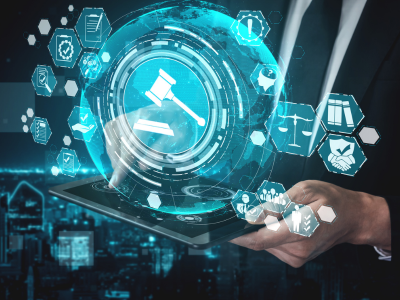Artificial intelligence (AI) refers to automatic systems that use data to make decisions, predictions, or recommendations. AI provides great opportunities to improve many aspects of our lives—how we work, learn, and live. Nevertheless, there are both pros and cons to using AI in the workplace. Advantages include increased efficiency and productivity, innovation, and removing remedial and/or tedious tasks from employees’ job descriptions. But as AI becomes more advanced and capable of taking on tasks previously performed by humans, job displacement has become a real concern. Employees will need to adapt to new roles and may be resistant to doing so, and new ethical concerns will undoubtedly arise.
Pop Culture Come to Life
Since at least the 1980’s, popular movies have made us consider what would happen if AI became a reality. The Terminator made us consider what could happen if robots start thinking for themselves (and possibly decide humans are no longer needed). Then The Matrix showed a robotic AI enslaving humanity, and Ex Machina made us question how human emotions can be reconciled with non-human entities.
Although AI has been used in back-office applications for some time, it has much more relevance now that consumer-focused platforms such as ChatGPT, OpenAI, Google’s Gemini, and Microsoft’s Copilot have made the technology much more mainstream.
Executive Order on AI
Although probably not inspired by box office hits, the Biden administration—concerned about the fast pace with which AI has been advancing—issued an Executive Order on the Safe, Secure and Trustworthy Development and Use of Artificial Intelligence, directing the Department of Labor (DOL) to create a roadmap that advises employers and AI developers with principles aimed at taking advantage of AI technologies while protecting today’s workforce.
With input from the public, workers, employers, and developers, the DOL developed “Artificial Intelligence and Worker Well-being: Principles for Developers and Employers.” The DOL’s AI principles focus on several topics and provide the following:
- Centering worker empowerment. Workers and their representatives, especially those from underserved communities, should be informed of and have genuine input in the design, development, testing, training, use, and oversight of AI systems for use in the workplace.
- Ethically developing AI. AI systems should be designed, developed, and trained in a way that protects workers.
- Establishing AI governance and human oversight. Organizations should have clear governance systems, procedures, human oversight, and evaluation processes for AI systems for use in the workplace.
- Ensuring transparency in AI use. Employers should be transparent with workers and job seekers about the AI systems that are being used in the workplace.
- Protecting labor and employment rights. AI systems should not violate or undermine workers’ right to organize, health and safety rights, wage and hour rights, and antidiscrimination and antiretaliation protections.
- Using AI to enable workers. AI systems should assist, complement, and enable workers and improve job quality.
- Supporting workers affected by AI. Employers should support or upskill workers during job transitions related to AI.
- Ensuring responsible use of worker data. Workers’ data collected, used, or created by AI systems should be limited in scope and location, used only to support legitimate business aims, and protected and handled responsibly.
There’s a strong focus on making AI advantageous for workers rather than threatening their jobs. In addition to the DOL’s principles, the White House has issued a fact sheet regarding “critical steps to protect workers from risks of artificial intelligence.” The fact sheet makes it clear the Biden administration wants workers to be more than just aware of AI in the workplace. It suggests that workers have input in design, development, testing, and oversight of AI, among other things. Further, AI systems shouldn’t interfere with workers’ rights to organize and should be aimed at improving job quality and supporting or upskilling workers.
Tracking Employees with AI
With the increased use of AI for streamlining many aspects of businesses, there has also been an increased use of AI to track employees. The DOL’s Wage and Hour Division (WHD) issued field assistance bulletin 2024-01 outlining how AI may be used to track employee’s work time, including travel, wait time, and breaks. The bulletin discusses the possible interplay between AI and related federal laws such as the Fair Labor Standards Act (FLSA), the Family and Medical Leave Act (FMLA), the Providing Urgent Maternal Protections for Nursing Mothers Act (PUMP Act), and the Employee Polygraph Protection Act (EPPA).
The WHD cautions that although “AI has the potential to help improve compliance with the law . . . . [w]ithout proper human supervision, . . . these technologies can pose potential risks to workers with respect to labor standards and may result in violations of the laws enforced by the WHD.”
Bottom Line
With the growth of AI tools and AI-driven business applications, you are wise to keep well-apprised of legal developments that are sure to affect how you manage your businesses and employees. AI is no longer virtual reality and instead is a current landscape that both employers and employees will need to navigate.
Marylou Fabbo is a partner at the firm Skoler, Abbott & Presser, P.C., in Springfield, Massachusetts, and can be reached at mfabbo@skoler-abbott.com.

